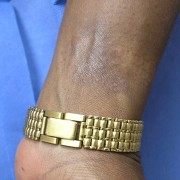Nickel Contact Dermatitis in US Adults-A 53-Year Review- Synopsis
Authors: Goldenberg A, Vassantachart J, Lin EJ, Lampel HP, Jacob SE. Nickel Allergy in US Adults-A 53-Year Review of Indexed Cases. Dermatitis. 2015 Jul 14.
Synopsis by Janna Vassantachart, MSIV — Loma Linda University School of Medicine
For 53 years, nickel has been unparalleled as the most common allergen documented in patch-tested US patients of all ages. In 1994, the European Union (EU) decreased rates of sensitization by enacting a Nickel Directive to regulate nickel release to no more than 0.5 µg/cm2/week. No such directive currently exists in the USA.
This study conducted a literature review of peer-reviewed adult nickel dermatitis cases published within the United States to identify trends over the past decades, sources of nickel sensitization, and regional variations. The results of the study demonstrated:
• Between 1962 and 2015, there were 74 articles published reporting 18,251 cases of nickel sensitivity in US adults.
• Over the past decades, the frequency of published articles on nickel sensitivity has continuously increased with a significant correlation (r = 0.798, P = 0.057). Compared to only one article published between 1960 and 1970, in the last 5 years, 30 articles have been published.
• Five articles reported occupational exposures such as a stethoscope, chalk, and a military-issued lanyard chain from an identification neck tag (aka ‘‘dog tag’’). The most commonly reported nonoccupational sources were Essure contraceptive microinserts and Amplatzer septal occluders for atrial septal defects.
• Geographically, 27 US states have had at least 1 reported case of adult nickel dermatitis.
Most nickel dermatitis cases seen clinically are neither patch-tested nor captured in the literature, allowing for a prospering hidden nickel epidemic. However, this study reveals that even the literature has seen a significant increase in published cases over the past decades. Rising rates of US nickel ACD highlight the need for medical professionals, legislators, and manufacturers to advocate for an EU-like Nickel Directive to regulate the release of free nickel.

